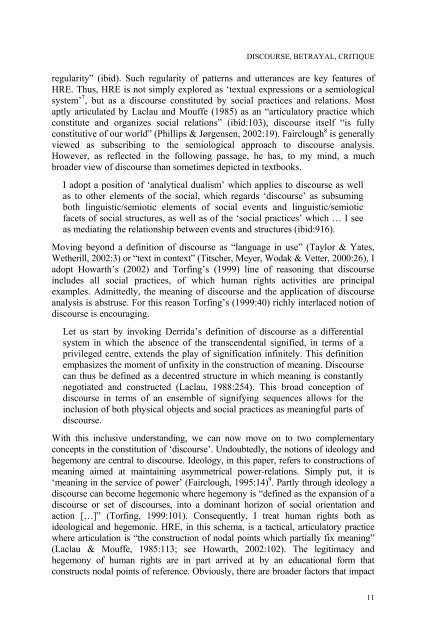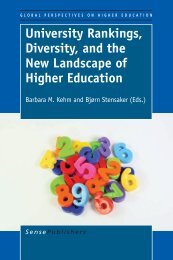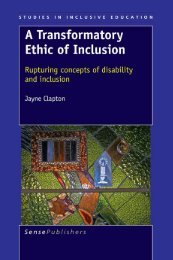Safe Spaces Human Rights Education in Diverse Contexts
Safe Spaces Human Rights Education in Diverse Contexts
Safe Spaces Human Rights Education in Diverse Contexts
You also want an ePaper? Increase the reach of your titles
YUMPU automatically turns print PDFs into web optimized ePapers that Google loves.
DISCOURSE, BETRAYAL, CRITIQUE<br />
regularity” (ibid). Such regularity of patterns and utterances are key features of<br />
HRE. Thus, HRE is not simply explored as ‘textual expressions or a semiological<br />
system’ 7 , but as a discourse constituted by social practices and relations. Most<br />
aptly articulated by Laclau and Mouffe (1985) as an “articulatory practice which<br />
constitute and organizes social relations” (ibid:103), discourse itself “is fully<br />
constitutive of our world” (Phillips & Jørgensen, 2002:19). Fairclough 8 is generally<br />
viewed as subscrib<strong>in</strong>g to the semiological approach to discourse analysis.<br />
However, as reflected <strong>in</strong> the follow<strong>in</strong>g passage, he has, to my m<strong>in</strong>d, a much<br />
broader view of discourse than sometimes depicted <strong>in</strong> textbooks.<br />
I adopt a position of ‘analytical dualism’ which applies to discourse as well<br />
as to other elements of the social, which regards ‘discourse’ as subsum<strong>in</strong>g<br />
both l<strong>in</strong>guistic/semiotic elements of social events and l<strong>in</strong>guistic/semiotic<br />
facets of social structures, as well as of the ‘social practices’ which … I see<br />
as mediat<strong>in</strong>g the relationship between events and structures (ibid:916).<br />
Mov<strong>in</strong>g beyond a def<strong>in</strong>ition of discourse as “language <strong>in</strong> use” (Taylor & Yates,<br />
Wetherill, 2002:3) or “text <strong>in</strong> context” (Titscher, Meyer, Wodak & Vetter, 2000:26), I<br />
adopt Howarth’s (2002) and Torf<strong>in</strong>g’s (1999) l<strong>in</strong>e of reason<strong>in</strong>g that discourse<br />
<strong>in</strong>cludes all social practices, of which human rights activities are pr<strong>in</strong>cipal<br />
examples. Admittedly, the mean<strong>in</strong>g of discourse and the application of discourse<br />
analysis is abstruse. For this reason Torf<strong>in</strong>g’s (1999:40) richly <strong>in</strong>terlaced notion of<br />
discourse is encourag<strong>in</strong>g.<br />
Let us start by <strong>in</strong>vok<strong>in</strong>g Derrida’s def<strong>in</strong>ition of discourse as a differential<br />
system <strong>in</strong> which the absence of the transcendental signified, <strong>in</strong> terms of a<br />
privileged centre, extends the play of signification <strong>in</strong>f<strong>in</strong>itely. This def<strong>in</strong>ition<br />
emphasizes the moment of unfixity <strong>in</strong> the construction of mean<strong>in</strong>g. Discourse<br />
can thus be def<strong>in</strong>ed as a decentred structure <strong>in</strong> which mean<strong>in</strong>g is constantly<br />
negotiated and constructed (Laclau, 1988:254). This broad conception of<br />
discourse <strong>in</strong> terms of an ensemble of signify<strong>in</strong>g sequences allows for the<br />
<strong>in</strong>clusion of both physical objects and social practices as mean<strong>in</strong>gful parts of<br />
discourse.<br />
With this <strong>in</strong>clusive understand<strong>in</strong>g, we can now move on to two complementary<br />
concepts <strong>in</strong> the constitution of ‘discourse’. Undoubtedly, the notions of ideology and<br />
hegemony are central to discourse. Ideology, <strong>in</strong> this paper, refers to constructions of<br />
mean<strong>in</strong>g aimed at ma<strong>in</strong>ta<strong>in</strong><strong>in</strong>g asymmetrical power-relations. Simply put, it is<br />
‘mean<strong>in</strong>g <strong>in</strong> the service of power’ (Fairclough, 1995:14) 9 . Partly through ideology a<br />
discourse can become hegemonic where hegemony is “def<strong>in</strong>ed as the expansion of a<br />
discourse or set of discourses, <strong>in</strong>to a dom<strong>in</strong>ant horizon of social orientation and<br />
action […]” (Torf<strong>in</strong>g, 1999:101). Consequently, I treat human rights both as<br />
ideological and hegemonic. HRE, <strong>in</strong> this schema, is a tactical, articulatory practice<br />
where articulation is “the construction of nodal po<strong>in</strong>ts which partially fix mean<strong>in</strong>g”<br />
(Laclau & Mouffe, 1985:113; see Howarth, 2002:102). The legitimacy and<br />
hegemony of human rights are <strong>in</strong> part arrived at by an educational form that<br />
constructs nodal po<strong>in</strong>ts of reference. Obviously, there are broader factors that impact<br />
11














